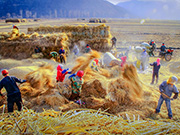

Gongmian noodles are seen processed for air drying at a workshop in Gengjiazhuang Village of Gaocheng District in Shijiazhuang, capital of north China's Hebei Province, July 13, 2016. The Gongmian noodles produced in Gaocheng used to be a tribute to the royal family in ancient times. Through special processes, each noodle is uniformly thin and hollow. Listed as provincial intangible cultural heritage of Hebei in 2013, Gongmian noodles are popular on local and foreign markets. Food of a particular place is an important symbol of local geographic and cultural characteristics. Food carries history and tradition, leads the tide of trade, strengthens diplomatic relations, disseminates and promotes culture. Food has been serving as connections between people around the world. In ancient times, food such as grapes, pomegranates, walnuts, coriander, cucumbers and sesame seeds were introduced to China along the Silk Road. Nowadays, thanks to the Belt and Road Initiative, red wine, coffee, dried fruits, meat, seafood, and dairy products from foreign countries enter the homes of ordinary people, turning daily meals into feasts with exotic cuisines. (Xinhua/Pu Dongfeng)
 |  |

 Award-winning photos show poverty reduction achievements in NE China's Jilin province
Award-winning photos show poverty reduction achievements in NE China's Jilin province People dance to greet advent of New Year in Ameiqituo Town, Guizhou
People dance to greet advent of New Year in Ameiqituo Town, Guizhou Fire brigade in Shanghai holds group wedding
Fire brigade in Shanghai holds group wedding Tourists enjoy ice sculptures in Datan Town, north China
Tourists enjoy ice sculptures in Datan Town, north China Sunset scenery of Dayan Pagoda in Xi'an
Sunset scenery of Dayan Pagoda in Xi'an Tourists have fun at scenic spot in Nanlong Town, NW China
Tourists have fun at scenic spot in Nanlong Town, NW China Harbin attracts tourists by making best use of ice in winter
Harbin attracts tourists by making best use of ice in winter In pics: FIS Alpine Ski Women's World Cup Slalom
In pics: FIS Alpine Ski Women's World Cup Slalom Black-necked cranes rest at reservoir in Lhunzhub County, Lhasa
Black-necked cranes rest at reservoir in Lhunzhub County, Lhasa China's FAST telescope will be available to foreign scientists in April
China's FAST telescope will be available to foreign scientists in April